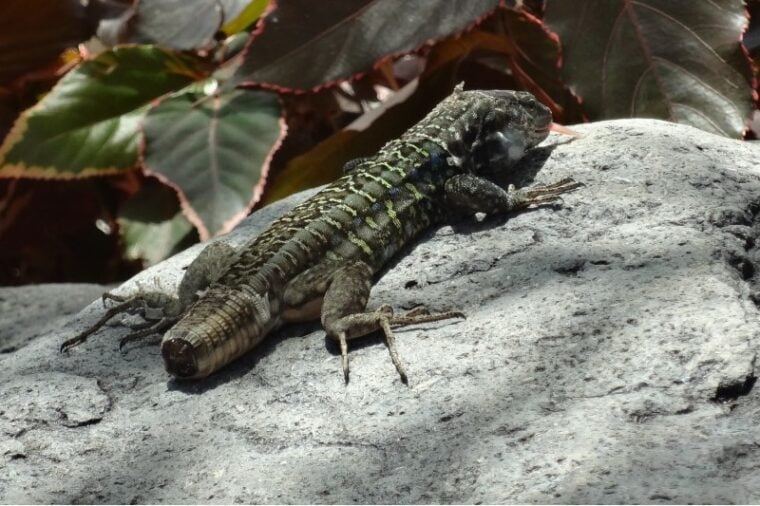
Click to Skip Ahead
Dropping a tail is an effective defense mechanism for lizards. Animals have unique defense mechanisms when they sense they’re in danger. For example, texas horned lizards can squirt blood from their eyes up to five feet. Hairy frogs can crack their toe bones and push them through their skin to create makeshift claws. Sea cucumbers can expel toxic-chemical-containing internal organs out of their anus and then grow them back.
While tail dropping is much less gruesome and creepy than the aforementioned defense mechanisms, it’s something many reptiles can do. For example, most lizards can drop their tails, and some can even regrow them.
Keep reading to learn why and how lizards drop their tails and the science behind this fascinating defense technique.
Why Do Lizards Drop Their Tails?
As we mentioned in the introduction to our blog, lizards drop their tails as a defense mechanism when they sense they’re in danger. This mechanism is called caudal autotomy. The term autotomy literally translates to “self” and “sever” in Greek.
If a lizard’s tail is grabbed onto or the reptile becomes stressed, the muscles along the fracture plane will start pulling away from each other. This is called a reflex muscle spasm. These muscles pulling apart is what causes the detail to detach.
After the tail detaches, it often continues to move, which serves as another way to distract the predator, giving the lizard enough time to escape.
How Do Lizards Drop Their Tails?
Along lizards’ tails are weak spots known as fracture planes. These are the areas where the tail can detach itself. When in the heat of the moment, the lizard can decide from which fracture plane it would like to sever its tail. Then, when it’s time for the lizard to activate their defense mechanism, it bends its tail at a side angle to initiate the dropping process.
The internal structure of a lizard tail features micropillars, prongs, and nanopores that act like segments that lock into one another, like how plugs go into sockets. There are eight cone-shaped prongs, which are essentially bundles of muscles arranged in a circular shape. They fit into their corresponding sockets, which consist of smooth walls. Every prong is covered in micropillars that look like tiny mushrooms.
Each micropillar is pockmarked with nanopores. Studies suggest that the spaces between these two structures help slow the spread of the initial fracture. In addition, the micropillars and nanopores assist with adhesion 15 times more than prongs without micropillars. It’s a beautiful relationship that scientists often refer to as the Goldilocks Principle; the tail has the just-right amount of attachment, so it doesn’t fall off too easily, but will quickly drop when necessary.

When Do Lizards Drop Their Tails?
Tail dropping is a last resort for lizards. They won’t suddenly lose their tail if a dog barks at them too loudly. It might detach, however, if you were to step on it by accident, grab it too forcefully, or if a heavy object were to drop on it.
What Happens After Lizards Drop Their Tails?
Tail autonomy has developed over time to the point where, when the tail falls off, there will be no blood loss. Most lizard species will regrow over six to 12 months, though the regrowth speed can depend on factors such as the environment and diet.
Research suggests that the regrown tail is sometimes made of tubes of cartilage instead of vertebrae. The new growth starts as a stub until it can grow to a decent length, though they often don’t grow to the same length as the original tail. The regrown tail tends to be more muted in color, too. Sometimes the new tail grows and even becomes bifurcated (forked) as it regrows.
Though it may save the lizard’s life, the defense mechanism doesn’t come without consequences. Lizards use their tails to run, balance, leap, and mate, so these basic activities are affected until they can regrow the tail.
In addition, the tail normally serves as a fat reservoir. Lizards who lose their tails lose this reservoir. Owners of pet lizards who’ve lost a tail should be mindful about this and ensure they feed their lizard appropriately, as their capacity to fast is severely limited if they’re missing their tail.
Other Interesting Facts
Conclusion
A lizard needs to feel its life is in immediate danger to detach its tail, and when it doesn’t grow back, it can severely impact the life of the affected reptile, especially if it’s living in the wild. Thankfully, it seems that lizards will only resort to this defense mechanism as an absolute last resort, so it’s unlikely that pet lizards will ever face the dangers necessary to result in tail loss.
Lizard tail dropping is a fascinating defense mechanism that has baffled scientists for years. It is somehow even more intriguing now that the science behind regeneration is known. But, as with many things in the animal world, there is more to it than meets the eye, and no hard and fast rule for how the tail will regrow—if it does at all.
Featured Image Credit: meineresterampe, Pixabay









